If you want to sell products online, you basically have 2 options:
- Start your own e-commerce store.
- Sell on a marketplace
Setting up your own e-commerce store isn’t hard. You can easily use platforms like Shopify to list and sell products on your own domain.
What is hard about opening your own e-commerce store, though, is getting traffic to it.
You have to run ads, build up SEO traffic, or become a social media whiz to get people to visit your website. Of the people who actually do click to your site, few will buy.
What’s different about selling on online marketplaces is that the traffic problem is nonexistent. Marketplaces like eBay and Amazon have millions of users, and if you can list your product on a marketplace where the user base significantly overlaps your target audience, you have a business.
Sure, you still have to get your products in front of these users, but this is a much simpler task than driving traffic to a brand-new website.
There are cases where starting your own e-commerce store is the best option for your business, but if an online marketplace is the direction you want to take, here are 10 of the best online marketplaces with their pros and cons.
1. eBay
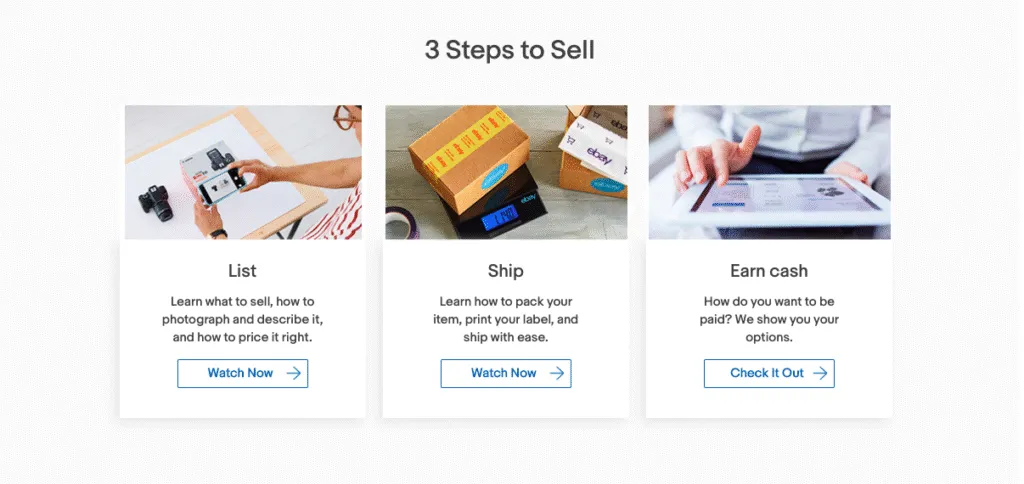
eBay has been a global marketplace since 1995 when it was first founded by Pierre Omidyar. Its headquarter location is in San Jose, CA where, over time, it has become one of the 10th largest online marketplaces in the world.
Pros of Selling on eBay
- With 75 product categories, eBay gives you an array of opportunity to sell your products. Product categories include, but are not limited to, Fashion, Electronics, Sporting Goods, and Collectibles.
- You can sell both new and used products. Actually, a fun fact most people don’t know is that 81% of eBay’s sales consist of New Products.
- The auction model can give you high profits – especially on collectibles. High valued items can start as low as $1 and go as high as $600, for example.
- Payout is instant on eBay with PayPal. Merchants using the marketplace can get an instant payout through PayPal with a 3% fee. You can transfer your revenue to your bank account (processed in 2-3 business days) or a CashCard. Since 2021, you can receive your money from eBay without Paypal.
- On eBay, you are responsible for shipping, which means you have flexibility with the packaging and design of your shipment.
- eBay is dropshipping software-friendly. You can even sell on eBay Walmart products using the best Walmart to eBay dropshipping software. You can also do it via Amazon to eBay dropshipping software for Amazon products.
Cons of Selling on eBay
- Competition is intense. Not only are you competing with the other 25 million sellers, but now eBay is implementing a white box containing the “Add To Cart” or “Buy It Now” button. This means they may only feature one seller per listing, which can limit your visibility on the platform. While this box – along with eBay’s Guaranteed Delivery – is making things really easy for buyers, it’s complicating the marketplace for sellers who have based their business around the auction model.
- It can take a while before you sell your actionable items. It doesn’t always jump from $1 to $1,000 unless you want to patiently wait it out.
- It’ll require some expenses. Shipping is on you, and though that offers you a lot of flexibility, you will have to cover the costs of carriers and returns. eBay’s return policy really falls on you. They give you five different options to list your products under.
- You are customer service. All returns and product inquiries fall on your company’s lap. We all know this part can be a bit tedious and frustrating at times. However, this is important as many are thinking that eBay will soon base search results on the highest ranking store.
2. Amazon
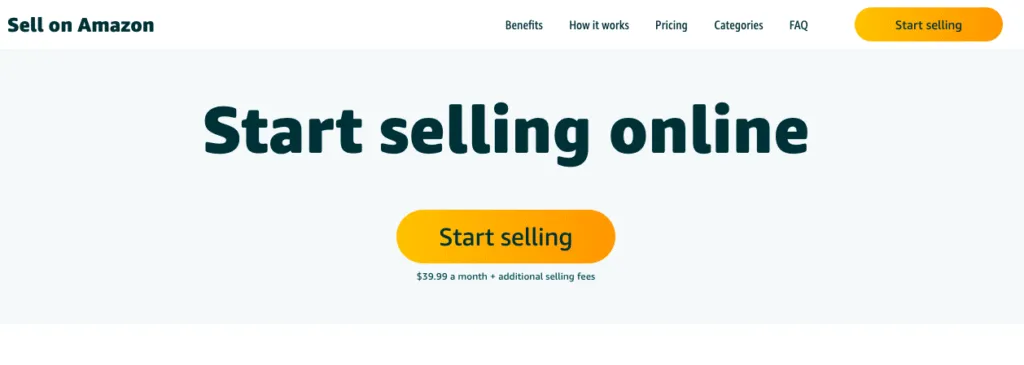
Amazon was founded in 1994 by Jeff Bezos in Seattle, WA. The platform started out selling books until it expanded its selection to music and videos, along with letting other vendors sell their books on the site. Currently, merchants looking to sell on Amazon have the option of an Individual or Professional Selling Plan. Here are the pros and cons of selling on Amazon
Pros of Selling on Amazon
- Wide customer audience. Currently, Amazon has a total of 300 million active accounts, with a monthly average of 30 million mobile app users. The possibility of making sales is 100% there, especially if you’re a Prime seller.
- You have 37 product categories to choose from. It’s not as much as eBay, but the sub-categories are almost endless. The product categories include, but are not limited to, Toys & Games, Electronics, Camera & Photo, Video Games, and Books. Just under the Books category, you have sub-categories of Paperback, Hardcover, and Audio, for example.
- Fulfilled by Amazon (FBA) is included in your seller account! FBA is an all-inclusive fulfillment service available to sellers. All you need to do is send them a portion of your inventory and they take care of picking, packing, and shipping the sold products. Amazon will do all your inventory management.
Cons of Selling on Amazon
- Everyone is competing – including Amazon. Amazon has built its brand with products such as Alexa and the Kindle, adding competition to the other 2 million sellers on the marketplace. Many sellers have found that Amazon has undercut some companies to have the lowest price.
- Your brand awareness will suffer. When people buy from you, they’ll be telling their friends they bought from Amazon, not from your store.
- You will not qualify to sell in all product categories unless you’re a Professional Seller.
- Amazon has a two-week payout for US sellers. This is to ward off pesky scammers who sell dozens of orders and deliver no product, but it can put a strain on your cash flow.
3. Walmart Marketplace
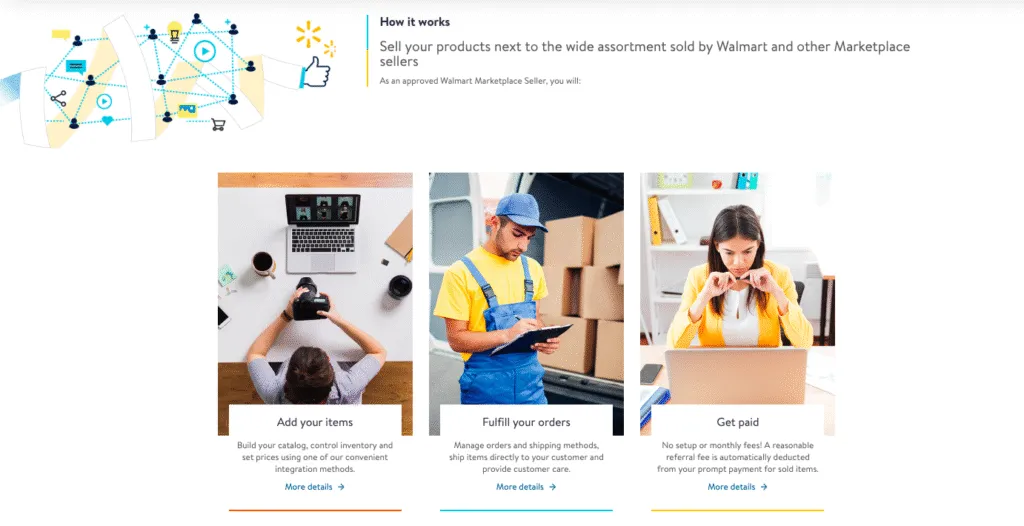
Walmart has been around since 1962, but was not incorporated until 7 years later in 1969. Sam Walton was the founder of both Walmart and Sam’s Club – which is now under Walmart’s corporation. Their headquarters is in Bentonville, AR.
Walmart is mostly known as a discount department store. While Amazon has been known to be all about customer service, Walmart’s staple is its Everyday Low Price. Once Walmart acquired several other companies, it began to extend its availability to other businesses as an online marketplace.
Pros of Selling on Walmart
- There are no setup fees to start selling on Walmart. Instead of a monthly or annual fee, you only have a referral fee per product sale. Each fee depends on the product price, so it will vary on the percentage.
- You have the potential to reach a very wide customer base instantly. We are talking about an average of 289 million Walmart users every month.
- With such a high customer base, the chances of brand exposure are higher. Many sellers on Walmart.com have found that visits to their own e-commerce site increase after joining the marketplace.
Cons of Selling on Walmart
- You may have low-profit margins. Given that you have to stick to Walmart’s everyday low price motto, you may want to pick the right products to list on their site.
- Listings are first-come-first-served. Unlike Amazon, where your place in the search results depends mostly on your customer reviews, Walmart focuses on chronological order.
- If your prices are too high, you run the risk of being delisted by a competitor.
- No Dropshipping Allowed. Walmart has a strict shipping policy that doesn’t allow you to send purchases out in non-branded packaging. The package must not include any additional materials that are not about Walmart.
- Though you get brand exposure through their site, there’s not much else you can add to the packaging to promote your brand or stimulate reorders.
- Seller support is not the best. Unlike eBay, where you have many forms of contact — or even Amazon, where can talk or chat with someone — Walmart only has email. This will make it difficult to get immediate assistance.
4. Bonanza
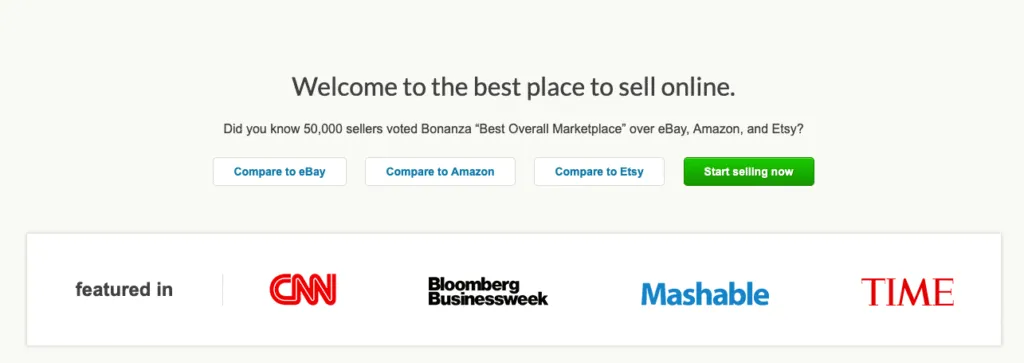
Bonanza was founded back in 2007 by Bill Harding in Seattle, WA. If eBay and Amazon had a baby marketplace, that would be it. Bonanza credits themselves as seller-centric, making sure that sellers have an awesome platform available to them to sell their products.
Rather than having an online store, what you’ll get is a Booth. This is an original concept from Harding, who got the idea to start Bonanza after a bad garage sale. Sellers can start out with a free account and can upgrade to a Gold, Platinum or Titan account status. Each account level can benefit you differently.
Pros of Selling on Bonanza
- You’re available to over 2 million monthly users on the site. Sure, when compared to other online marketplaces it may not seem like much, but 2 million is a world of chances, especially with an average of 54 of those being seller visits.
- Bonanza has a great importing tool that integrates with eBay, Amazon, Etsy, and Shopify. This is a great tool if you’re a merchant in multiple marketplaces. You can also edit listings in batches.
- You can sell used or new! Sure, marketplaces always have that used option, but not many of them highlight it. Plus, you can sell and re-sell items at negotiable prices.
- As soon as you list it, it’s published on Google and Bing Shopping.
Cons of Selling on Bonanza
- Bonanza charges fees on each sale, so they don’t make money until you do. Said fees are pretty complicated and can cut into your margin if you’re not careful.
- They don’t ship products out for you. Like, eBay, you are responsible for that part along with returns. Nevertheless, it does give you the freedom to pick your carrier or to start an eBay dropshipping business.
- Item inventory is smaller than its competitors, limiting your options.
- If you’re under a free account, you won’t be able to promote your products in the marketplace.
5. Etsy
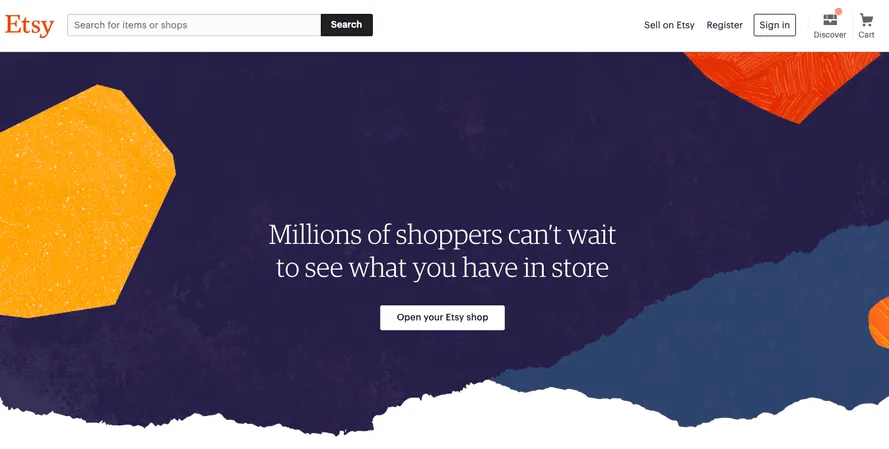
Etsy is the marketplace for creatives who are looking to sell their handmade, originally designed, and/or vintage items. The online marketplace was founded in 2005 by Josh Silverman in Brooklyn, NY.
Currently, there are two different accounts you could be under – Standard or Plus. You only have to pay a monthly fee of $10 for the Plus account, while Standard is free of charge. Additionally, they charge a Listing Fee, Transaction Fee, and Processing Fee.
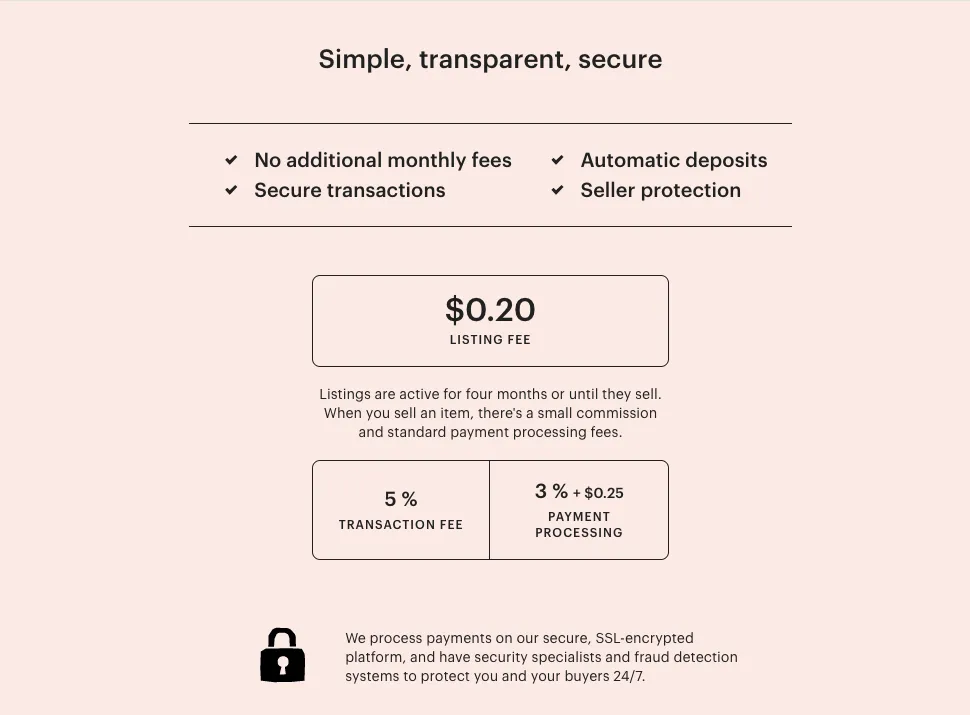
Pros of Selling on Etsy
- You’re selling to millions instantly. To be exact, you have an audience of over 15 million monthly users. This is a world of buyers that you can reach with your original products.
- Etsy has a very easy set up which allows you to start selling within minutes. Even if you have a digital product like Instagram Highlights, Etsy has a good program to get you started.
- You have several marketing tools at your disposal. This will help you make better decisions about things like SEO and email marketing. You can even create coupons to gain loyal customers.
- Etsy Payments allow you to get funds faster with automatic deposits. Those who use this payment method qualify for Etsy’s Seller Protection Policy, which protects your store from being scammed.
- The app has great communication tools for you and your buyers. Etsy has made it easy for buyers to contact the sellers regarding their order which gives you the opportunity to provide excellent customer service.
Cons of Selling on Etsy
- As Etsy popularity continues to grow, the market is becoming more saturated. Sellers have experienced that is hard to stand out if the product they are offering is too common. Keep in mind that listings that appear on the site’s search are chronological.
- If you want to use your PayPal account, that’s not possible anymore. Etsy is now requiring that Etsy Payments be used by eligible sellers.
- Your brand awareness will be slim to none. As with Amazon, and other marketplaces, your buyers will most likely tell their friends they got their product from Etsy, not your store.
6. Jet.com
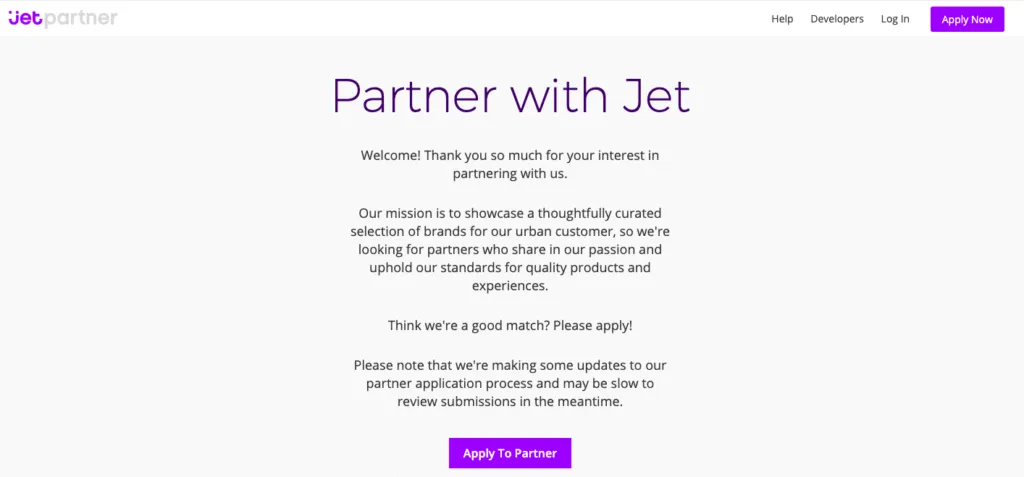
Jet.com was founded back in 2015 and shortly after, Walmart came along and bought them in 2016. Jet.com has always been the opposite of Amazon in the way that they sell their products. Rather than focusing on fast shipping, the founder of Jet, Marc Lore, though that customers wouldn’t mind waiting for their products if it meant they saved money.
Pros of Selling on Jet
- You get an instant audience, especially now that Walmart acquired Jet. Back in 2016, Jet had over 4 million active users. The platform has only grown in numbers and sales.
- Jet’s Partner Portal allows you to have insights on your sales and helps manage your inventory, making it easy to update.
- Jet offers a Rules Engine to help you compete more effectively. You can use the engine to modify your offer to be more competitive.
- Customers can forgo returns in order to save money. This also saves you time and headache!
Cons of Selling on Jet
- It will take a few weeks to be seen on Jet.com. Product listings are reviewed thoroughly before you can be approved to sell in the marketplace.
- Some say Jet hides the competition. Jet uses Unified Product Catalog which is meant to declutter search results for buyers. However, it doesn’t do much to help you check out your competitors prices.
- No dropshipping. Jet curates all the brands who apply to sell on their website in order to help their customers save money. If you do not have a warehouse with an optimal shipping method, odds are you won’t be approved.
7. AliExpress
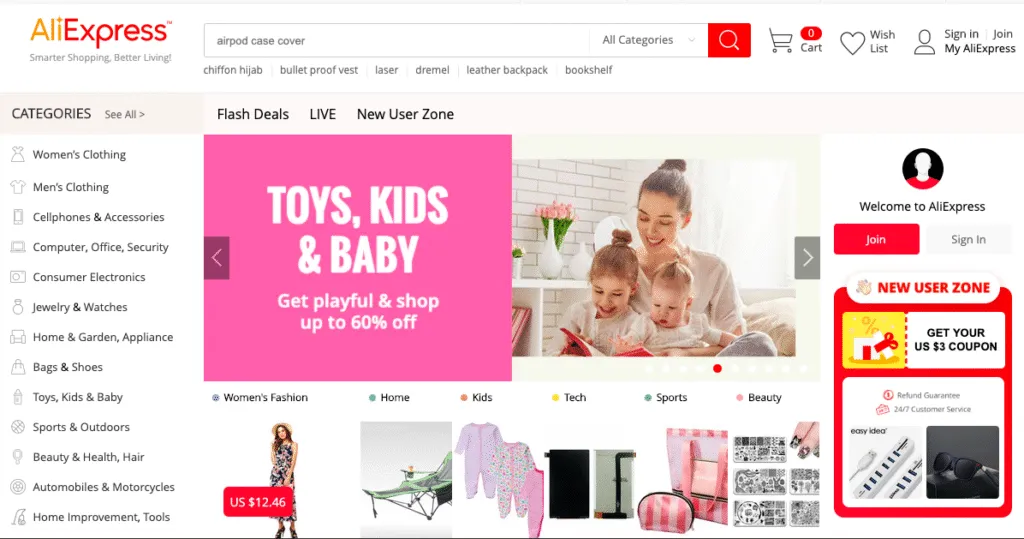
AliExpress is an online marketplace owned by Alibaba, a dropshipping supplier. The company launched back in 2010 in China. Unlike Alibaba, AliExpress sells smaller quantity wholesale items, making products really affordable for people around the world — not just businesses.
Pros of Selling on AliExpress
- AliExpress has a customer base of 100 million users all around the world.
- Once approved, you’re able to make your own branded shop on the AliExpress site.
Cons of Selling on AliExpress
- This online marketplace is not for small businesses. AliExpress is an international wholesale company who lends its platforms to other wholesalers.
- The registration process is a long and expensive one. There will be an annual technical fee along with other requirements such as Alipay account and an agent or brand management with appropriate documentation.
- Along with the annual technical fee, there is a 5-8% commission fee from the purchase total.
- You may incur a fee upwards of $1,500 if you want to change your store with them. This is a ridiculous amount of money, however, it is to keep sellers from changing their stores after too many bad reviews.
8. Wish
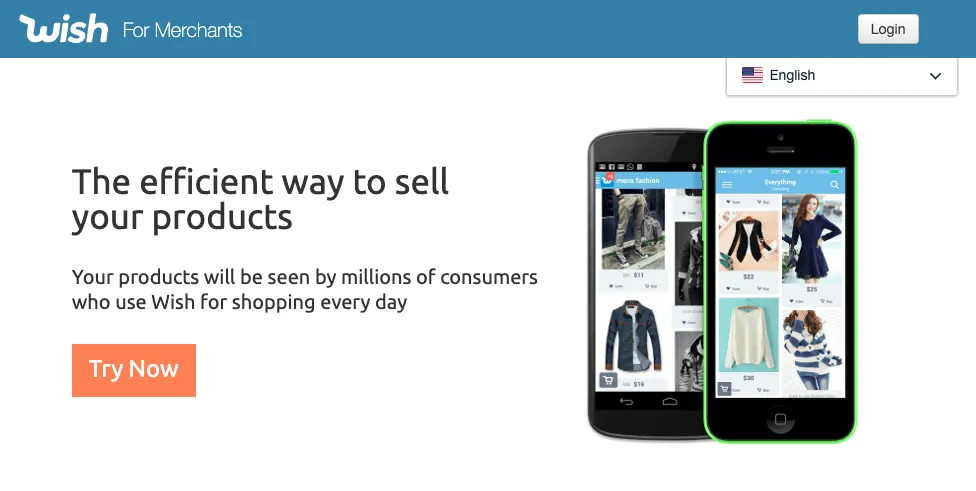
Wish was founded back in 2010 by Peter Szulczewski and Danny Zhang, and it’s located in San Francisco, CA. Wish is also a wholesale company where the sellers are manufacturers.
Pros of Selling on Wish
- Wish is a global marketplace with 300 million users throughout the United States and Europe. This includes users on their app, which spend about 30 minutes shopping every day, on average.
- Wish will help you reach your target market by showing them your product listings as suggestions. This, of course, depends on your buyers’ demographics, purchase behavior, and wishlists.
- You are able to promote your products with ads within the site.
Cons of Selling on Wish
- If buyers change their mind on their purchase and want a refund within the return policy, they can cancel their order and have their refund approved. Even when you have provided the tracking information and shipped the order, you will have to accept the return.
- You are not able to communicate with customers. This makes returns even more difficult since you’re not able to help them exchange the item or resolve the issue.
- Even if you have free shipping, Wish will charge buyers a shipping rate. As sellers, we can understand that they want to make money, but doing this can cost you sales as a seller.
- You run the risk of Wish upping your listing price and then pocketing the money. Several sellers have shared stories about this.
9. NewEgg Marketplace
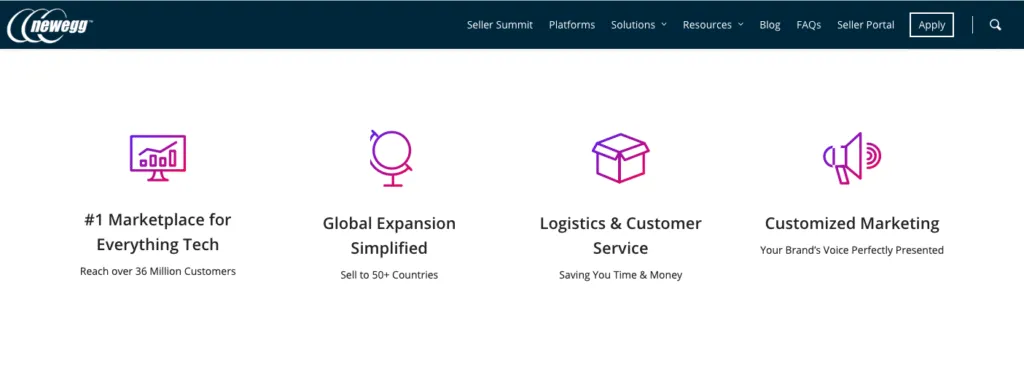
NewEgg was an original retail company founded by Fred Chang back in 2000. They didn’t become an online marketplace until 2010 when they launched as NewEgg Marketplace. Currently, it’s headquarters are located in City of Industry, CA.
When it comes to aesthetics, the site reminds you a bit of Amazon, as they have a similar color scheme. Their product categories range from Apparel to Computer Hardware and Electronics.
Pros of Selling on NewEgg
- NewEgg reaches over 36 million buyers in total. Additionally, it’s available in over 50 countries.
- Depending on the pricing plan you choose, you can list a large quantity of products each month.
- You don’t need a warehouse. NewEgg has Shipped by NewEgg (SBN) available for ProSellers! This is a fulfillment center where you just send them the inventory to store. Once sold, they’ll pick, pack, and ship it for you! You can even use a Multichannel Fulfillment option where they handle fulfillment for your inventory that you sell through other platforms!
- As a seller, you have two ways of selling with NewEgg — manually, or through API integration via a third party. This gives you lots of business model flexibility.
Cons of Selling on NewEgg
- Competition left and right. With so many consumers, and similar products, how can there not be?
- You have to watch out for the fees. NewEgg has three account levels: Standard, Professional, and Enterprise. The Standard Account does not have monthly fees, but they don’t come with the benefits of SBN discounts.
- If you’re selling using their Multichannel Fulfillment, NewEgg will not handle returns if products were not purchased on their site.
10. Cratejoy
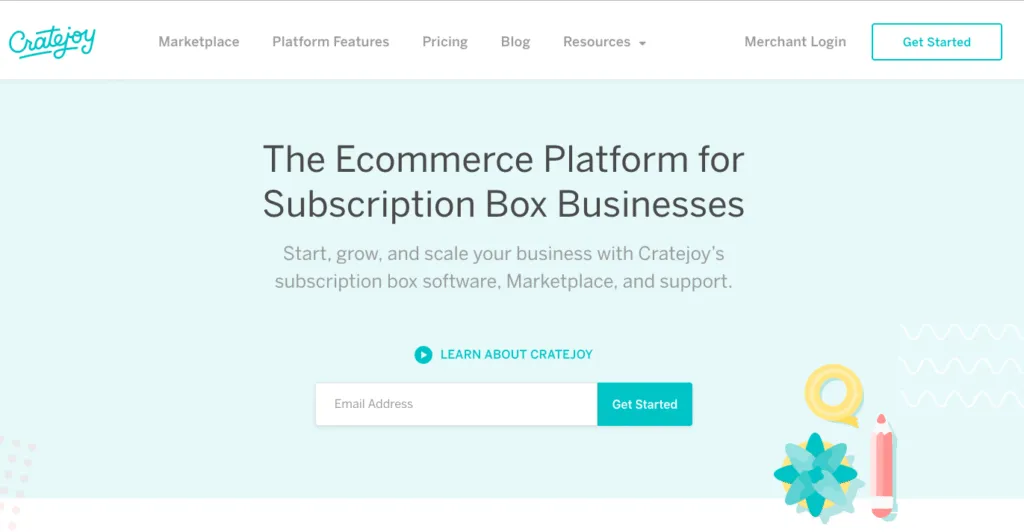
Cratejoy is the online marketplace for subscription box sellers. The platform was founded back in 2014 for subscription box fanatics.
Pros of Selling on Crately
- No account fees — if you don’t want them. If you’re a seller who already has their site up and running, you can extend your business over to Cratejoy for no additional monthly costs. Those who don’t have the tools ready can get started with their Monthly Plan option.
- Cratejoy gets 4 million views every day and there are over 40,000 sales each month. The market is there for you to make money.
Cons of Selling on Crately
- Transaction fees do apply. Per transaction, Cratejoy charges sellers a $0.10 flat fee plus credit card processing fees.
- You are responsible for packaging and shipping. Cratejoy does not provide you the supplies for the subscription box. Instead, you list your box with the products you already have available.
Final Thoughts on Online Marketplaces to Sell Products
When it comes to selling online, both e-commerce stores and marketplaces are effective for your sales and growth. Building your own store gives you control and branding power, but requires a traffic strategy. Marketplaces like eBay, Amazon, and others provide built-in customers but come with fees and competition. The best one is dependent on the product you are selling, the goals you want, and the availability of your resources. For many sellers, starting with a marketplace offers quicker sales and experience, while a long-term plan may include launching your own store.
Start Selling Smarter with ZIK Analytics
Ready to choose between your own store and a marketplace? With ZIK Analytics’ eBay product research tool, you can see what’s actually selling on eBay before you invest. Validate demand, uncover profitable niches, and find products that win. Don’t waste time guessing—use real data to launch your online business with confidence.
You can also search Alibaba by image to match competitor products with factory-direct suppliers and validate whether your pricing is competitive before listing.
Frequently Asked Questions on Online Marketplaces to Sell Products
Here are some frequently asked questions about current online marketplaces that work great when selling products online:
What is the most popular online marketplace?
The most popular online marketplace in the world is Amazon, with over 300 million active customer accounts globally. It consistently leads in sales volume, product variety, and customer reach, followed by eBay, Walmart, and Alibaba in terms of traffic and usage.
What is the meaning of an online marketplace?
An online marketplace is a digital platform where multiple third-party sellers list and sell products or services to customers. The marketplace operator manages the website, processes payments, and may provide fulfillment, while sellers handle inventory and pricing. Examples include Amazon, eBay, and Etsy.
What is the best marketplace in Europe?
The top European marketplace is Amazon, it’s the #1 marketplace across many major countries (UK, Germany, France, Italy, Spain) with very high traffic, broad product range, and strong infrastructure.
What is the most common example of a marketplace?
The most common example of a marketplace is Amazon, where millions of third-party sellers list products alongside Amazon’s own offerings. Other well-known examples include eBay for auctions and fixed-price sales, and Etsy for handmade and vintage goods.
Is Shopify a marketplace?
No, Shopify is not a marketplace. It’s an e-commerce platform that lets you create and manage your own online store under your brand. Unlike Amazon or eBay, Shopify doesn’t provide a shared customer base, you’re responsible for driving traffic and sales to your store.
Is Facebook an online marketplace?
Yes, Facebook has an online marketplace called Facebook Marketplace. It allows users to buy and sell new or used items locally. While it’s not a traditional e-commerce site like Amazon, it connects buyers and sellers within their community through the Facebook platform.
Do marketplaces make money?
Yes, marketplaces make money by charging sellers fees. Common revenue streams include listing fees, transaction commissions, subscription plans, advertising, and fulfillment services. For example, Amazon earns from seller fees and FBA, while eBay profits from listing and final value fees.
Are online marketplaces safe to use?
Online marketplaces are generally safe to use, but security depends on the platform and seller. Trusted sites like Amazon, eBay, and Etsy have buyer protection, secure payments, and review systems. Still, buyers should check seller ratings, read product descriptions carefully, and avoid suspicious deals.












